- Jul 19, 2021
Expert Tips on How to Fish a Brush Pile
Brush piles produce summer crappie. We all know that. Two top crappie anglers explain how to catch the most crappie out of each brush pile.
The formula is simple. Using the correct presentations equals success catching more and bigger crappie from brush piles.
“When I say presentation it means a number of things,” said professional crappie angler Dan Dannenmueller. “Everything from distance from the brush pile to the boat, casting distance, lure retrieve, lure color, lure size, angle of cast from the boat and everything else I can change to incite a crappie to bite.”
Before fishing a brush pile, Dannenmueller will use his sonar units from a distance to see if it has crappie in it and where they are located. He likes to stay at least 50 feet from the brush pile to avoid spooking the crappie before moving closer.
Longtime lure designer and lifetime Oklahoma crappie fisherman George Toalson concurs presentation is the key, with a similar attention to detail while relying almost exclusively on a cast-and-retrieve approach.
“Casting to brush piles is my favorite way to crappie fish,” Toalson said. “It might look like to others that all I’m doing is making a cast and slowly reeling back in, but in reality, I’m painting a picture in my mind of everything that’s going on below. Today’s electronics are amazing, but they don’t do the catching.”
Location
“The time of the day and location of the sun will influence what part or side of the brush pile the crappie will be on,” Dannenmueller said.
Water clarity also influences the depth of the brush piles Dannenmueller will fish. In gin clear water Dannenmueller will stay way off and fish deeper brush piles. He’ll work closer and shallower in stained water.
“My lure is telling me intricate detail about the cover and how crappie are relating to limb sizes, edges and depth. Getting dialed in is all part of the fun of fishing,” Toalson said.
“I don’t really fish too deep, I’d say 10, 12, up to about 16 feet is kind of my magical depth range. Casting distance varies by depth and conditions, as well; perhaps as short as 10 feet or maybe a few times more than that over a big pile. But I’m always controlling, always ‘feeling’ my retrieve,” Toalson added.
Casting or Vertical Presentations
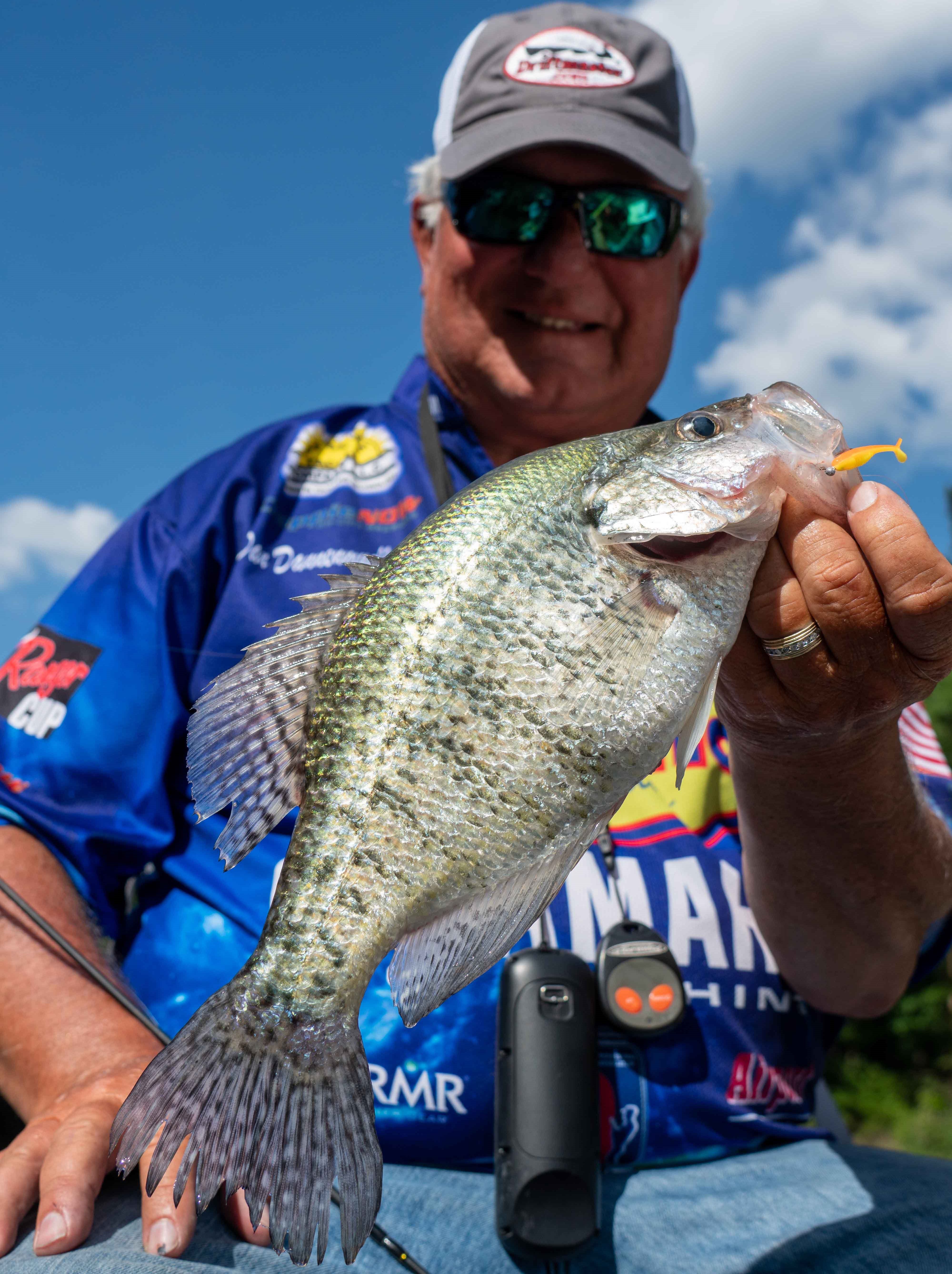

“There are two ways to present lures to crappie in a brush pile. Either you cast to them from a distance away or vertically drop the lure,” said Dannenmueller, “Vertically can be a straight drop or allowing it to swing freely like a pendulum directly under the rod, suspending above or into the brush pile, depending on where the crappie are positioned.”
When casting to crappie on brush piles, Dannenmueller likes using a Bobby Garland 2-inch Hyper Grub combined with a Road Runner head in stained water. The underspin-style jighead produces flash and vibration for a reaction strike.
Casting past the brush pile, Dannenmueller will count down the lure to the depth where the suspending crappie are located and start reeling. If the crappie are tighter in cover, he will let the lure sink to the bottom, then reel it back slowly while lightly bumping into the branches.
“Sometimes your lure will just be falling, and a crappie will strike it. Always watch you’re fishing line for those bites,” said Dannenmueller.
Another way Dannenmueller retrieves when casting is to start at the base of the brush pile and work his way up, using a start and stop motion and allowing the lure to fall through the brush pile.
When he moves closer to the brushpile, Dannenmueller will continue to fish with the Hyper Grub. He will make shorter casts, but for the suspending crappie he will fish above the brush pile first and then fish slowly through the branches.
Toalson will be casting. He makes no bones about it. It’s a process he’s refined from years of doing it, starting as a kid fishing with his parents and other family members. The instilled passion not only led to his becoming the designer of many Gene Larew and Bobby Garland soft-plastic baits, but additionally has given him a lifetime of on-the-water experience.
“To me, if I’m casting, I’m covering a lot more water and therefore putting my bait in front of more fish than if I was vertical jigging over a given spot,” Toalson said. “Again, every cast is strategic based on what I learned from the previous one. Catch one or get a bite, throw there again. Nothing, adjust your cast.”
Triggering Strikes
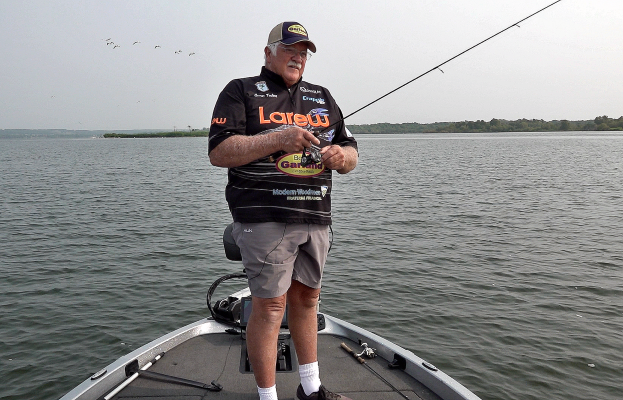

If you stop catching crappie from a brush pile, Dannenmueller recommends changing the presentation angle. He accomplishes this by repositioning his boat. After getting into a new position, Dannenmueller will make the same length of cast and use the same retrieve as he did before moving.
Moving to the backside of a brush pile will change the bait’s moment relative to the direction of sunlight or direction of the wind.
Toalson says “listen” to what the crappie are telling you. Every cast is like a scouting mission from which you can pick up on pieces of information to help you put the pieces of the fish-catching puzzle together.
“It starts with keeping your bait in the water and keeping it moving,” he said. “Albeit sometimes really, really slow, I’m always swimming my jig and often putting a little ‘English’ on it.”
That’s his description for the slightest shaking of his rod tip, a trick he says often triggers a strike.
“Crappie seem to always be watching, often following your lure and sometimes it’s the slightest changeup that results in a strike,” Toalson said. “Think about when your jig bumps into a limb or when you pull free from a snag and a fish hits … it’s a reaction trigger, and you can do the same thing putting a little English on it every now and then.”
Toalson also warns not to overdo it, advising to spend a little time jiggling a bait in a pool or bathtub to see how even the slightest of rod tip wiggle amplifies bait movement below.
Downsize Your Lure
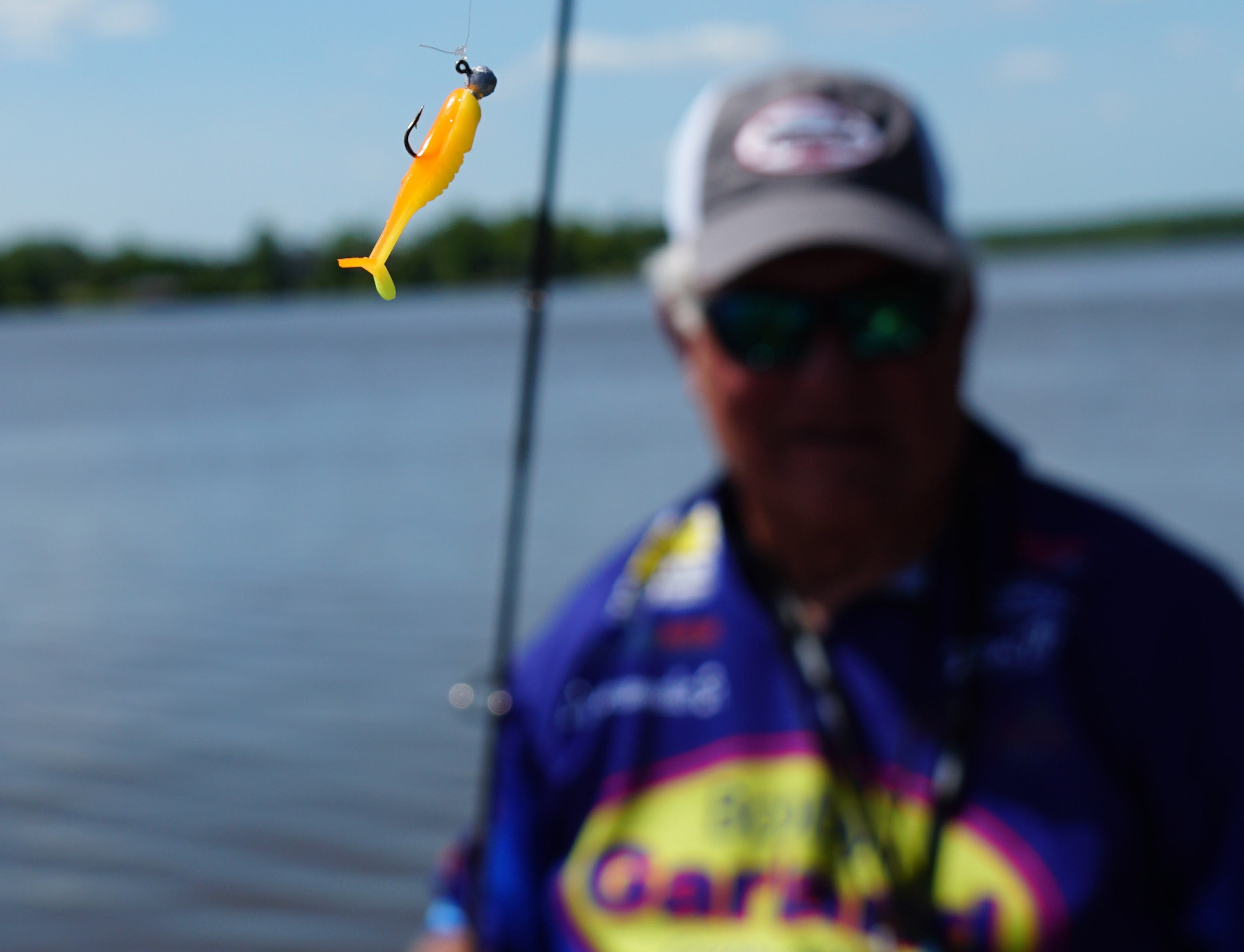

Another trick Dannenmueller will use to coax extra strikes from a brush pile is to downsize his lure.
“I will try changing and downsizing my lure before leaving a brush pile if I am still seeing them on my electronics. That means going to a smaller jighead and maybe adding a split shot weight to be able to cast out the lighter lure along with getting it down to where the fish are located,” Dannenmueller said.
His new favorite lure for downsizing is the Bobby Garland Itty Bit Slab Hunt’R rigged on a 1/32-ounce Bobby Garland Itty Bit Jighead. Dannenmueller still casts past the brush pile with the Itty Bit Slab Hunt’R, but instead of using a steady retrieve, he will start reeling and then pause the retrieve, allowing his jig to drop.
Toalson typically chooses the Itty Bit Swim’R when he wants to downsize. “I designed the Itty Bit Baby Shad Swim’R for those times when crappie simply want something tiny for whatever reasons,” he said. “And don’t think it’s just for little fish, as I’ve caught some of my biggest crappie on this little bait.”
“To give the Itty Bit it’s built-in action, always rig it on a lightweight jighead, like a 1/32- or 1/48-ounce. Don’t kill it by putting it on a bigger head. Instead, use the split shot 8 inches or more above it, and that way the bait can still swim like it’s supposed to do.”
Electronics
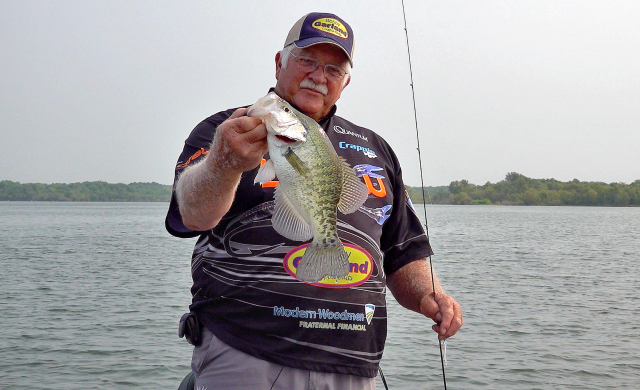

Depending on the size of the brushpile, you might have to cast to the right, left and down the center to find where the crappie are located, especially if you don’t have live sonar technology like Garmin LiveScope. For anglers with live sonar, it’s a matter of keeping the lure in the strike zone and assessing how the crappie are reacting to passive and aggressive lure presentations.
Dannenmueller’s boat is tricked out with marine electronics, having two Garmin units on the front deck. Each unit has its own Valor Marine LiveScope Down Tube, which allows Dan and his wife Sue the ability to steer their own transducer. This allows Dan focus on one brush pile, while Sue fishes a different brushpile.
You’ll find the latest in electronics on Toalson’s boat, too, but you’ll still often see him tossing a marker buoy alongside a brush pile. It’s his reference point for casting, pinpointing catches and staying back from the cover to do his casting.
Lure Colors
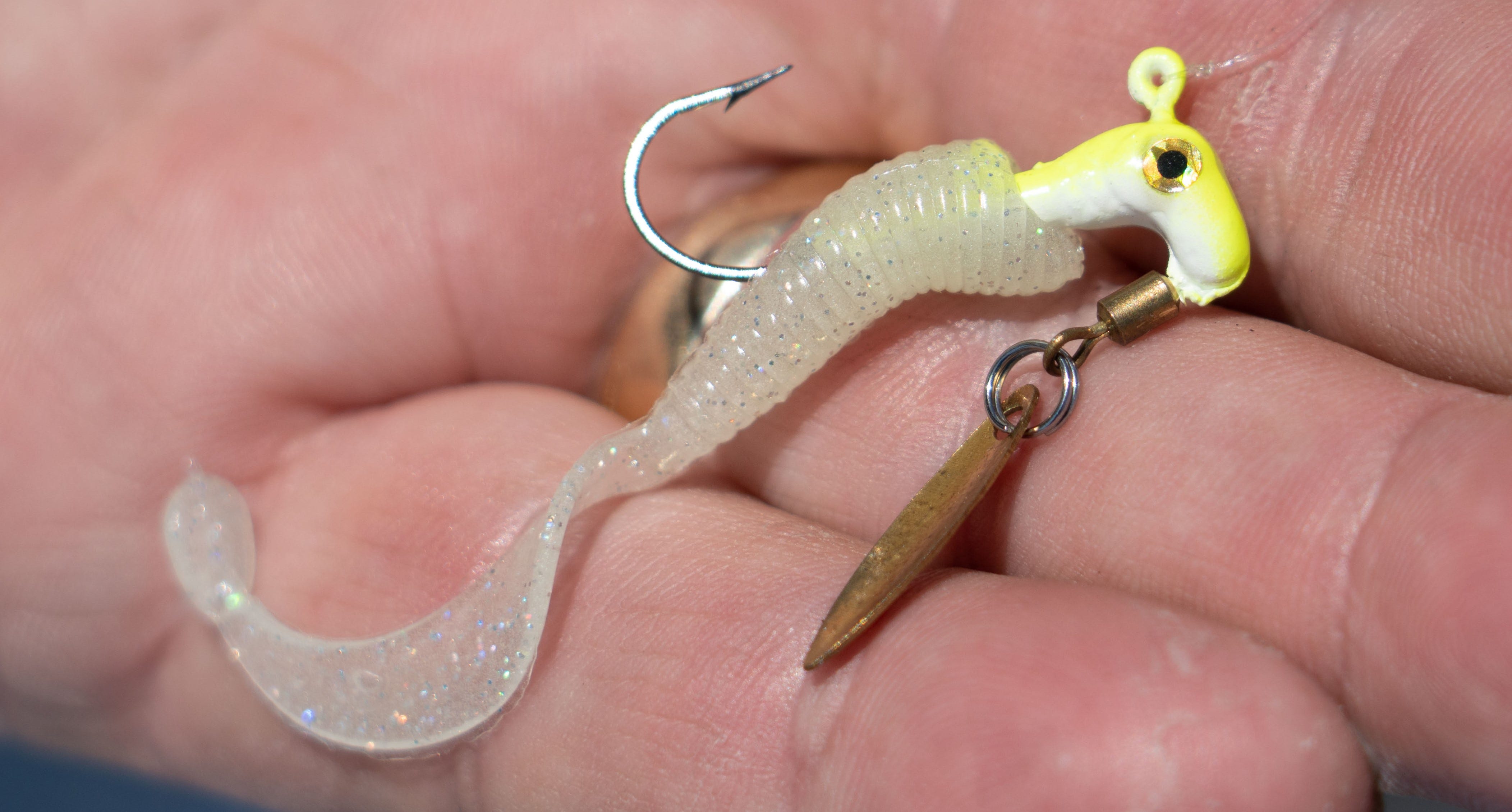

On sunny days in stained water conditions, Dannenmueller’s go-to lure color patterns for Hyper Grubs feature white, pearl and chartreuse. He also like to have silver sparkles or purple or green flake to suggest scales falling off a baitfish.
For the Itty Bit Slab Hunt’R, Dannenmueller has been using Cajun Cricket and Pearl White in stained water but will switch to Blue Ice or Monkey Milk for clear water.
“No doubt colors do matter, or at least the shades they become underwater do, based on my years of fishing and diving,” Tolson said.
He noted that most anglers have a favorite or two, and he’s no exception. “Glacier and Monkey Milk are usually on at least one of my rods, regardless of water color.”
Tackle
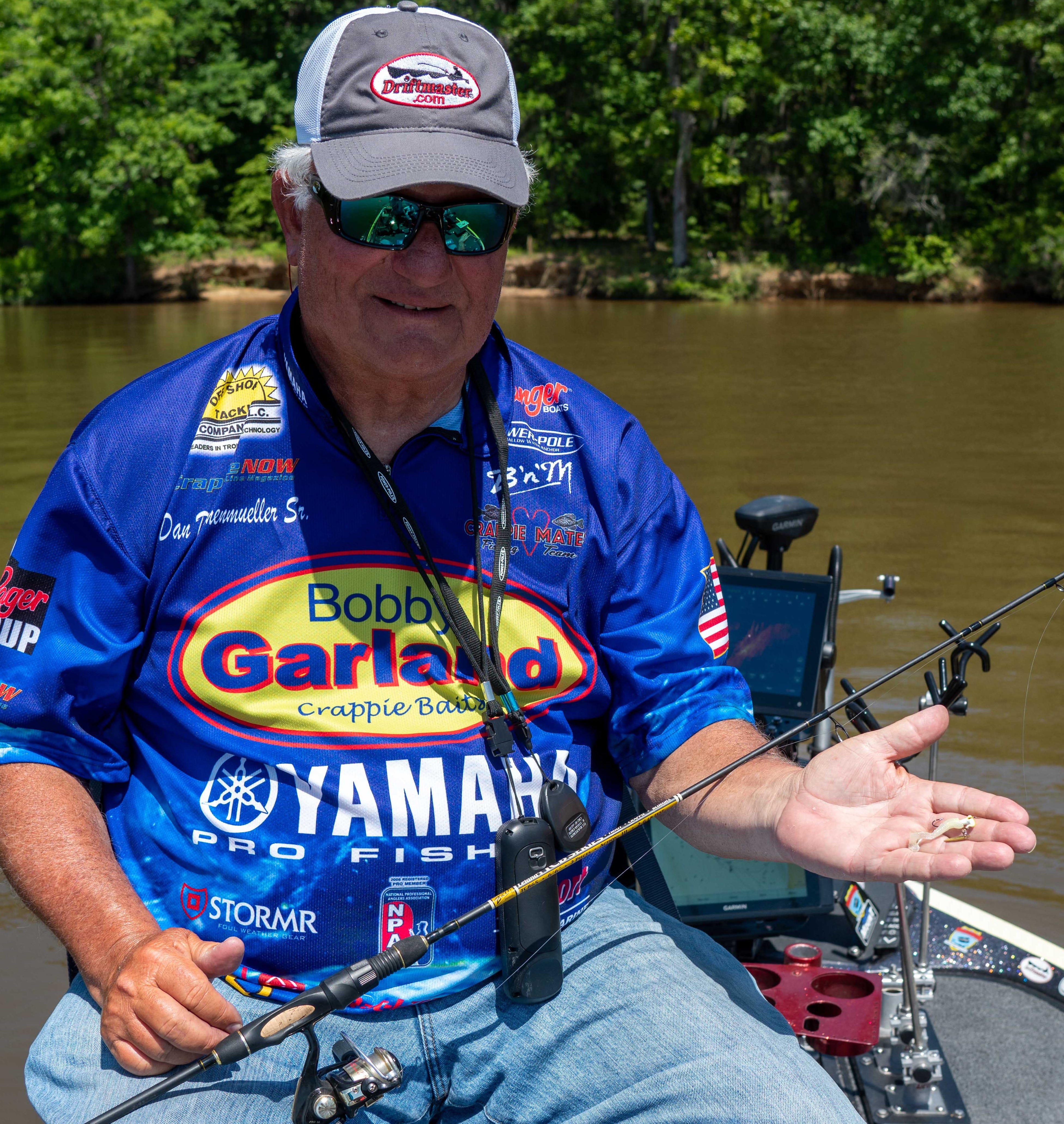

For casting lightweight jigs and soft plastic trailers, Dannenmueller uses a B’n’M Pole two-piece 6-foot 6-inch Leland’s TCB Series ultralight combined with a size 50 reel and 6-pound test monofilament line.
“Yes, you will hang up sometimes,” Dannenmueller continued. “Yes, you will lose some lures, but that’s all part of fishing brush piles. As long as you are getting hung up sometimes that’s okay because that means you are in where the crappie are.”
Toalson’s casting gear consists of a super sensitive rod, 6 feet in length (to cast light jigs farther) with medium-sized guides (less weight) and a super-smooth reel. He opts for 6-pound fluorocarbon for most of his crappie fishing, but will go down to 4-pound test if casting Itty Bits.
“Good rods, reels and line, doesn’t have to mean expensive … it just means you have to spend some time in the tackle departments to find what fits you and your style best,” Toalson said. “But trust me, sensitive rods and smooth reels make a huge difference in being able to detect almost otherwise indistinguishable bites. We’ve all seen the underwater videos of that kind of bite happening.”
Marker Buoy Wisdom
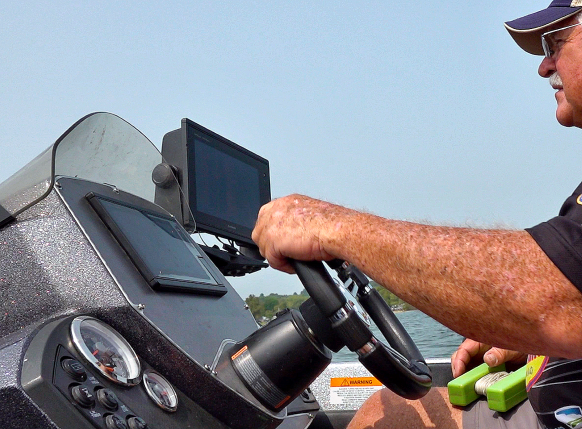

Dannenmueller
- Use a marker buoy. Yes, it’s old school, but they are reliable.
- Drop the marker buoy next to the brush pile not in it.
- Move 30- to 50-feet away from the marker buoy before fishing it. Staying off the brush pile will keep you from spooking the crappie.
- Go Stealthy. Buy a drab buoy or spray paint your marker a dark color to keep other anglers from seeing your marker buoy so easily.
Toalson
- You’ll find them in my boat.
- Strategically place it so you can use as a constant reference for positioning and casts.
- It’ll happen, but try to avoid snagging the marker rope with your lure or boat motor, which relocates it.
Dan’s 3 Key Tips for Catching Brush Pile Crappie
- Be stealthy when approaching the brush pile.
- Use your electronics to see the number of fish, their size and how they are orienting to the brush.
- Cast beyond the brushpile and bring your lure to where the fish are by swimming it, dropping it vertically in or allowing it to pendulum back to the crappie.
George’s 3 Key Tips for Catching Brushpile Crappie
- Cast using a bait with an active swim tail (my favorites: Baby Shad Swim’R, Slab Hunt’R, Itty Bit Swim’R.
- Super sensitive rod, flawless-reeling reel and small diameter fluorocarbon line.
- Always use a loop knot, rig your bait perfectly straight on the jighead and keep it moving.



